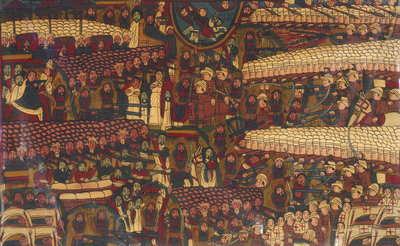Javascript must be enabled to continue!
painting (art)
View through Europeana Collections
The painting illustrates an interesting Ethiopian painting convention of depicting the 'good' full-faced and the 'bad' in profile only. In this painting the Ethiopians are always shown with all their facial features, but the Italians are only ever shown side-on.
The victory at Adwa was widely reported, strengthening Ethiopia’s image as defender of African independence. It became the source of pride and inspiration for Africans around the world. Today Ethiopians celebrate this historic victory with a national holiday on 2 March, the anniversary of the battle. Painting on cotton depicting the battle of Adwa. To the left are the massed armies of Ethiopia and to the right the Italian forces. In the centre of the painting, at the top, above the battle field, is Saint George, the patron saint of Ethiopia. The saint appears in a halo of red, gold and green, the colours of the Ethiopian flag. To the left of Saint George is the seated figure of Emperor Menelik. To the left of the Emperor is a large crowd of priests with white turbans, some carrying large crosses. Three priests carry holy tabots on their heads concealed beneath red cloths. Below, on horseback, is Empress Taytu with a revolver urging the Ethiopian troops to victory. The Italian forces are depicted as rows of pale-faced troops with white pith helmets.
Horniman Museum and Gardens
Title: painting (art)
Description:
The painting illustrates an interesting Ethiopian painting convention of depicting the 'good' full-faced and the 'bad' in profile only.
In this painting the Ethiopians are always shown with all their facial features, but the Italians are only ever shown side-on.
The victory at Adwa was widely reported, strengthening Ethiopia’s image as defender of African independence.
It became the source of pride and inspiration for Africans around the world.
Today Ethiopians celebrate this historic victory with a national holiday on 2 March, the anniversary of the battle.
Painting on cotton depicting the battle of Adwa.
To the left are the massed armies of Ethiopia and to the right the Italian forces.
In the centre of the painting, at the top, above the battle field, is Saint George, the patron saint of Ethiopia.
The saint appears in a halo of red, gold and green, the colours of the Ethiopian flag.
To the left of Saint George is the seated figure of Emperor Menelik.
To the left of the Emperor is a large crowd of priests with white turbans, some carrying large crosses.
Three priests carry holy tabots on their heads concealed beneath red cloths.
Below, on horseback, is Empress Taytu with a revolver urging the Ethiopian troops to victory.
The Italian forces are depicted as rows of pale-faced troops with white pith helmets.
Related Results
painting, painting, painting, painting, painting, painting, painting, painting, painting, painting, painting, painting, painting, painting, painting, painting, painting, painting, painting, painting, painting, painting, painting, painting, painting, paint
painting, painting, painting, painting, painting, painting, painting, painting, painting, painting, painting, painting, painting, painting, painting, painting, painting, painting, painting, painting, painting, painting, painting, painting, painting, paint
"Here is portrayed three Moods of the Sky and the effects on the Fish and Animals. Sharks and Turtles come to the Surface when it is Raining. Wallabies and Kangaroos are out feedin...
The West Façade of the Church of Saint Mary in Utrecht
The West Façade of the Church of Saint Mary in Utrecht
Among the new genres in Dutch painting developed during the Golden Age was that of paintings of architectural motifs. This sub-genre took on its own independent existence, in a man...
painting (art)
painting (art)
A Central and Western Desert style acrylic on canvas painting that utilises the dot method which was brought to the attention of the wider public through the circulation of artwork...
Bamboo through the Four Seasons
Bamboo through the Four Seasons
Korean folding screens often have six panels, like those painted in Japan; more characteristically, however, Korean screens boast eight, ten, or even twelve panels. In some cases, ...
Saint Catherine of Alexandria
Saint Catherine of Alexandria
Saint Catherine of Alexandria by Caravaggio is one of the works in the Collection whose complete provenance allows its history to be traced almost from the time it was painted to t...
Waverly Oaks
Waverly Oaks
The painting career of the until then illustrator Winslow Homer began in 1859 when he moved from Boston to New York. He took easel painting lessons from the French-born landscape a...
River Scene
River Scene
In the field of French art, both academic and avant-garde, the 1880s were an unusually turbulent decade. The last official state-sponsored Salon, an institution that had been in ex...
Recent Results
painting (oil): "After the lion hunt" aka "W.F. Webb, South Africa"
painting (oil): "After the lion hunt" aka "W.F. Webb, South Africa"
William Frederick Webb and Captain W. Codrington at the end of a lion hunt in South Africa with a young African bearer about to skin the kill watched by 3 dogs; beyond an African b...
Mysteries of Trapani #198 | Misteri di Trapani #198
Mysteries of Trapani #198 | Misteri di Trapani #198
The Processione dei Misteri di Trapani or simply the Misteri di Trapani (in English the Procession of the Mysteries of Trapani or the Mysteries of Trapani) is a day-long passion pr...




